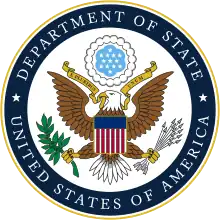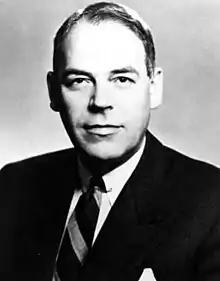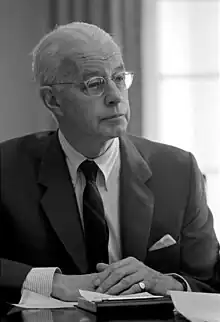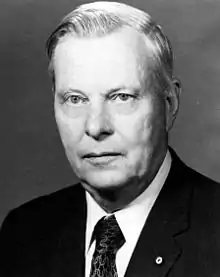| Ambassador of the United States to South Vietnam | |
|---|---|
 Seal of the United States Department of State | |
Incumbent None | |
| Nominator | The President of the United States |
| Inaugural holder | Donald R. Heath as Envoy Extraordinary and Minister Plenipotentiary |
| Formation | June 29, 1950 |
| Final holder | Graham A. Martin |
| Abolished | April 29, 1975 |
Following the end of World War II in Asia, France attempted to regain control of Vietnam, as part of French Indochina, which it had lost to Japan in 1941. At the conclusion of the First Indochina War, the country was split into two parts, the North and the South. The southern part was named the State of Vietnam under the leadership of former Emperor Bảo Đại. In 1950, the United States recognized the Bảo Đại government, established diplomatic relations, and sent its first ambassador to Saigon in South Vietnam, officially known as the Republic of Vietnam following the rise of President Ngô Đình Diệm in 1955. The US was opposed to the communist government of the North, led by Chairman Hồ Chí Minh, and did not recognize the northern regime.
At the end of the Vietnam War, the US Embassy in Saigon was shuttered and all embassy personnel evacuated on April 29, 1975, just prior to the capture of Saigon by North Vietnamese and Việt Cộng forces. Since the normalization of United States–Vietnam relations in 1995, the US Consulate General in Ho Chi Minh City stands adjacent to the site of the former embassy which was demolished in 1998. The US Ambassador to Vietnam is now seated in the US Embassy in Hanoi, the former capital city of North Vietnam and the current capital of the unified Socialist Republic of Vietnam.
Ambassadors
|
U.S. diplomatic terms |
|---|
|
Career FSO After 1915, The United States Department of State began classifying ambassadors as career Foreign Service Officers (FSOs) for those who have served in the Foreign Service for a specified amount of time. Political appointee A person who is not a career foreign service officer, but is appointed by the president (often as a reward to political friends). Appointed The date that the ambassador took the oath of office; also known as "commissioning". It follows confirmation of a presidential appointment by the Senate, or a Congressional recess appointment by the president. In the case of a recess appointment, the ambassador requires subsequent confirmation by the Senate to remain in office. Presented credentials The date that the ambassador presented his letter of credence to the head of state or appropriate authority of the receiving nation. At this time the ambassador officially becomes the representative of his country. This would normally occur a short time after the ambassador's arrival on station. The host nation may reject the ambassador by not receiving the ambassador's letter, but this occurs only rarely. Terminated mission Usually the date that the ambassador left the country. In some cases a letter of recall is presented, ending the ambassador's commission, either as a means of diplomatic protest or because the diplomat is being reassigned elsewhere and replaced by another envoy. Chargé d'affaires The person in charge of the business of the embassy when there is no ambassador commissioned to the host country. Ad interim Latin phrase meaning "for the time being", "in the meantime". |
| Portrait | Name | Type | Title | Appointed | Presented credentials | Terminated mission |
|---|---|---|---|---|---|---|
.jpg.webp) | Donald R. Heath[1] | Career FSO | EE/MP | June 29, 1950 | October 22, 1950 | June 25, 1952[2] |
.jpg.webp) | Donald R. Heath | Career FSO | AE/P | June 25, 1952[3] | July 11, 1952 | November 14, 1954 |
 | G. Frederick Reinhardt | Career FSO | AE/P | April 20, 1955 | May 28, 1955[4] | February 10, 1957 |
 | Elbridge Durbrow | Career FSO | AE/P | March 14, 1957 | April 16, 1957 | May 3, 1961 |
.jpg.webp) | Frederick E. Nolting Jr. | Career FSO | AE/P | March 15, 1961 | May 10, 1961 | August 15, 1963 |
.jpg.webp) | Henry Cabot Lodge Jr. | Political appointee | AE/P | August 1, 1963 | August 26, 1963 | June 28, 1964 |
 | Maxwell D. Taylor | Political appointee | AE/P | July 1, 1964 | July 14, 1964 | July 30, 1965 |
.jpg.webp) | Henry Cabot Lodge Jr. | Political appointee | AE/P | July 31, 1965 | August 25, 1965 | April 25, 1967 |
 | Ellsworth F. Bunker | Political appointee | AE/P | April 5, 1967 | April 28, 1967 | May 11, 1973 |
.jpg.webp) | Graham A. Martin | Career FSO | AE/P | June 21, 1973 | July 20, 1973 | April 29, 1975 |
Deputy Ambassadors
| Portrait | Name | Start date | End date |
|---|---|---|---|
 | U. Alexis Johnson | June 1964 | September 1965 |
 | William J. Porter | September 1965 | May 1967 |
 | Eugene M. Locke | May 1967 | January 1968 |
 | Samuel D. Berger | March 1968 | March 1972 |
 | Charles S. Whitehouse | March 1972 | August 1973 |
Notes
- ↑ Heath was also accredited to Cambodia and Laos but resident at Saigon.
- ↑ Promoted to Ambassador Extraordinary and Plenipotentiary
- ↑ Edmund A. Gullion was serving as Chargé d'affaires ad interim when the Legation in Saigon was raised to Embassy status on Jun 25, 1952.
- ↑ Reinhardt was reaccredited when South Vietnam became a republic; presented new credentials on February 24, 1956.